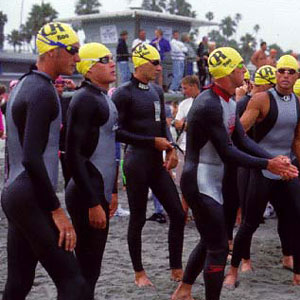USAT okays WTC rules

USA Triathlon, America's national governing body for triathlon, has granted World Triathlon Corporation (Ironman and 70.3 triathlon events) the ability to disallow swimskins in non wetsuit races, and wetsuits thicker than 5mm in wetsuit-legal events, for all WTC events taking place on or after September 1, 2010.
This date is the anniversary each year for Ironman qualifying, that is, races that occur after September 1 qualify entrants for the subsequent year's Kona and Clearwater World Championships, hence this effective date for the new rules.
This rule dispensation disallowing certain wetsuits and swimskins follows the publication, by WTC, in early February, of an Oceanside 70.3 athlete guide containing these new rules. Following a day of public discussion of these athlete guide rules on Slowtwitch.com, WTC quickly replaced the athlete guides with those making no reference to the rule dispensations they sought from USAT.
As of this week these rule dispensations have been granted by USAT for Ironman-owned and licensed events, though only after a sunset period.
Water temperature standards also change on this September 1 date. All WTC races after September 1 will be wetsuit legal if the water is 76.1°F or colder. This is the Fahrenheit equivalent of WTC's intent to disallow wetsuits above 24.5°C. This temperature standard is in between the ITU's 24°C and USAT's 78°F.
USAT stopped short of instituting a wetsuit thickness rule itself. Skip Gilbert, USAT's executive director, signaled that his organization would, "reopen the Ball State study," referring to an academic review of both the thermal and speed elements attending to water temperature and wetsuit thickness. The study, nearly two decades old, is the basis for the water temperature and legality rules USAT uses today.
This means that only a small fraction of the thousands of USAT-sanctioned multisport events held in the U.S. each year will be subject to these new wetsuit thickness, swimskin, and temperature cut-off rules.
"It will be near the end of the year before we make any kind of judgment one way or the other," said Gilbert, speaking on whether USAT will enact new rules for all its sanctioned events. "The impact would not take affect until 2011 or 2012. If we deem our temp [for wetsuit legality] should be other than 78, we might activate this for the next racing season [after January 1, 2010]."
About wetsuit thickness, Gilbert added that any rule change would not likely be effective until the 2012 season, to "give everybody [manufacturers, retailers and end-users] time to get into it." A sunset period is standard among governing bodies when rule changes affect equipment.
WTC also sought the ability for its entrants to use CE or AU helmet certifications in races taking place inside the United States (this because many foreigners travel with their foreign-purchased helmets to Ironman Florida, the Hawaiian Ironman, the Clearwater 70.3 Worlds, and other events). USAT declined this request, as it has done several years in a row, standing on the principle, according to Gilbert, that because the CE standard is, "not quite as strong, we don't want to go backward; we don't want to loosen the standards."
The dispensation requested on wetsuit thickness was, according to Gilbert, limited to wetsuits "5mm thick or less." Limiting our scope to wetsuit—and not grammatical—standards, what does a wetsuit "5mm thick or less" encompass?
Some rubber manufacturers adhere fabric jersey to rubber sliced to a thickness of 5mm, making the total wetsuit panel thickness 5.5mm or 6mm. Would such a wetsuit be legal in WTC races? "If I measured it, and it is, then I would say no," replied Jim Riccitello, head of WTC's officiating corps.
"But the main thing is, this rule puts us in line with international policy," argued Riccitello, yet he agreed that a more finely crafted text for the rule is needed. Such rule phrasing, "is not something that we've ever looked for," he said, and Riccitello feels that "since we're not a governing body, not a rule making organization," it's USAT's duty to craft the language defining a legal wetsuit.
"I would say that, like most of our rules, we look for guidance on technical issues from international and national federations," continued Riccitello. "It's not our job to define a wetsuit. We hope that that happens, but, up 'til now, we're simply adopting the international standard. My feeling, without knowing how wetsuits are constructed, manufacturers are adhering to 5mm or less. We're just trying to be proactive, before we have somebody waddling down to the swim start in a neoprene canoe."
Still, Riccitello acknowledges that, with USAT not likely to adopt any wetsuit product verbiage at all until late in 2010 at the earliest—for a rule not likely to be adopted until 2012—WTC may be forced to wade into the waters of wetsuit rule crafting. Should USAT not preempt WTC prior to September 1 of this year, "We'll attempt," said Riccitello, "to define what a wetsuit is."

